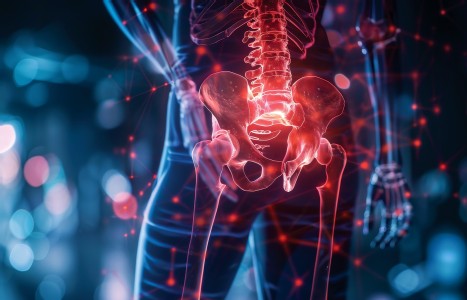Pelvic pain has a prevalence of >25% in women and >15% in men, and up to 50% of cases are undiagnosed, demonstrating that there is a definite need for pelvic care awareness among health care practitioners. As holistic practitioners, acupuncturists offer a safe space for clients and are often the practitioners clients seek out when nothing else has worked. Thus, acupuncturists are presented with an opportunity to serve an underserved population.
Putting the Big Hurt on Uterine and Ovarian Cysts
We have five powerful weapons in our arsenal that will do a number on gynecological cysts. They are acupuncture, herbology, hunger awareness training, focused deep breathing and posture retraining.
Each of the first three individually will resolve most cysts, and the last three will prevent their return, but applying all five together beefs up the process and ensures the body's ability to utterly destroy these unwanted intruders in a timely manner, and bar their reappearance.
What Is A Cyst?
A cyst is a closed pocket or pouch of tissue, mainly composed of protein molecules. It can be filled with air, fluid, pus, or other material. From a Chinese theoretical point of view, a cyst is a place where excess yin has stagnated. Cysts and tumors are both known as qi and phlegm stagnation.
A cyst is differentiated from a benign tumor in that a tumor is solid and can potentially turn toxic (cancerous). However, a benign tumor is also made up of protein molecules, is also seen as qi/phlegm stagnation, and will generally respond to the same treatments listed above.
Gynecological cysts and tumors will easily stagnate menstrual blood, leading to pain, menstrual irregularities of all types, excessive bleeding, amenorrhea, constipation and infertility. In addition, because stagnation often develops into excess heat, a woman will sometimes suffer from hot flashes, insomnia or a myriad of inflammatory conditions.
What Causes Gynecological Cysts To Develop?
There are two general causes of cysts: Liver qi stagnation and Spleen damp.
Liver regulates qi, and when liver is stagnated, qi is stagnated, especially along the Liver/Gall Bladder meridians. The groin area is encircled and dominated by the liver meridian. Qi moves fluids, and when the qi stagnates, fluids can stagnate, causing a buildup of fluid which we call phlegm. Thus, is born qi/phlegm stagnation in the liver meridian.
In the U.S., liver qi stagnation is almost universal, and the common causes of liver qi stagnation are worrying and poor posture. Worrying and all of its avatars, such as anxiety, dread, guilt, nervousness and resentment, result from thoughts that are stuck in the future or the past. Analyzing the past and planning for the future are useful cognitive abilities, but since neither the future nor the past actually exist, thoughts and emotions that linger there will not be in the flow of life and will necessarily become stagnated.
Stagnation of thoughts and feelings cause people to tighten various muscles and organs, consciously or unconsciously. This is particularly true for any structures lying along the liver or gall bladder pathways, such as the uterus or ovaries.
Two forms of unhealthy posture will cause the liver channels – which run along the medial seams of the legs - of women to contract and tighten up, contributing to stagnation of qi and fluids in the groin area. These two habits are extremely common among American women, many of whom are unknowingly and symbolically barricading their sexual organs and sexuality against imaginary threats during waking hours. They are:
- Standing and walking pigeon-toed, i.e. with one foot or both feet inverted.
- Standing and sitting with legs crossed instead of apart and firmly planted.
In most cases, for a pocket of yin to stagnate, there must exist an excess of yin in the first place. In the U.S., excess yin in the form of Spleen Damp is practically universal. Its most common manifestation is excessive body fat, the obvious result of overeating. In fact, any excessive body fat above the optimal lean zone - 5 to 10% for women – creates a large potential for qi/phlegm stagnation.
And with two-thirds of Americans overweight or obese, tumors and cysts have become quite common occurrences. This is easily demonstrated by statistical evidence, given that cancer is currently a close-second leading cause of American mortality.
Weapon 1: Acupuncture
Acupuncture's main claim to fame is its ability to move qi and with it, everything else. Many roads lead to Rome, and there are a variety of acupuncture protocols that will obtain successful results.
My particular method involves three simultaneous applications of acupuncture:
- Electro-acupuncture. First, ascertain exactly where the cyst lies, either by palpation, from the location of the patient's pain, or from information supplied by her gynecologist. Then, have her lie on her side so that you can place needles in abdominal and low back spots that will allow electrical current to run directly through the growth, being careful not to cross the mid-line. Thirty minutes of electrical stimulation will thoroughly hammer the unfortunate cyst.
- Needling the liver/gall bladder meridian points. While the patient is reclining on her side, locate tender points along the Liver and Gall Bladder meridians, especially on the feet and legs. Liver 3, GB 41, and Liver 8 are common candidates. In addition, Spleen 9 and Stomach 40 will help activate stagnation of damp and phlegm, respectively.
- Auricular acupuncture/acupressure. Using an electronic point indicator, find and needle or place press balls on the reactive points in the ear-uterus area, situated in the anterior corner of the triangular fossa.
Two to three treatments per week are optimal, while once per week will eventually get the job done.
Weapon 2: Herbology
We have a number of kung fu herbs in our Chinese pharmacopeia that share an extreme prejudice against cysts and tumors, and love nothing better than ambushing and chewing them up. Blood activators for the uterine area such as H. Leonuri yi mu cao, Rz. Curcumae e zhu, and Rz. Sparganii san leng can serve as chief herbs in a formula that must also take into account the degree of Spleen Damp, Liver qi stagnation, and internal excess heat found in each patient.
A combination like Frigid Extremities Powder si ni san can serve as a base formula for heavy Liver qi stagnation. Its magic will activate qi upward, downward, inward, and outward, and combined with the above blood activators will focus its attention on the lower abdomen.
For heavy dampness, a recipe like Two-Cured Decoction er chen tang will serve nicely as a base formula, with the addition of the above-mentioned kung fu herbs, some qi activators, and febrifugals when and where needed.
Weapon 3: Hunger Awareness Training
The only nice thing about American Spleen Damp is that it can usually be diagnosed from across the street. The more excess body fat a person is carrying, the more excess material – yin/damp - there will be sticking around that can contribute to unwanted structures like cysts and tumors.
This spleen damp sabotages the production of qi, especially Spleen qi and wei qi (protective qi), and also blocks the wei qi's ability to move around the body and attack unwanted growths.
Facilitating the process of getting lean and staying lean while simultaneously improving the health of the shen is the object of Hunger Awareness Training. This is accomplished by teaching patients to listen to and trust their own eating instincts, which will never lie to them or fail them. This protocol includes helping Americans eliminate the worry and hurry from their lives that overeating and carrying excess body fat will so effectively suppress.
Lean means clean. Getting lean includes allowing the body to recognize unwanted growths as food, since these structures are mostly composed of calorie-laden proteins.
Over this past summer, I used this method by phone and Internet with an acupuncturist in Maryland. She wanted to lose weight, as well as decrease the size of her ovarian cyst. We decided to use only it for this purpose, just to test it. Over the course of six weeks, she not only reached the lowest weight in her adult life, but learned from her gynecologist that her cyst had shrunk by two centimeters in diameter.
For more, read "Obesity is a Shen Problem."
Weapon 4: Focused Deep Breathing
Deep breathing, the basis of all meditative exercises such as qi gong, tai qi, and yoga, causes significant changes to the body's chemistry. From a Chinese point of view, the inhalation of air that is cooler than the internal temperature of the body will relieve pathogenic heat, while the exhalation will relax muscles that are continually held in contraction by those suffering from Liver qi stagnation.
Just before going to sleep every night, have your patient take 20 deep breaths, mentally focusing all the while on the lower abdomen, so that the uterus and surrounding muscles fall into a state of complete relaxation with every exhale. This will facilitate the liver's ability to regulate uterine qi, as well as allow free passage of the wei qi in its quest to search and destroy growths.
Eventually, this practice will set up a new pattern of a relaxed lower abdomen, helping to prevent the return of gynecological stagnation of any kind.
Weapon 5: Posture Retraining
Teach your patients that the habits of foot inversion and leg crossing will decrease circulation in the liver channels and the uterine region, and that it is an unconscious reflection of irrational fear. Question her on every visit as to whether she is practicing pointing the toes straight forward and standing/sitting with feet slightly apart and firmly planted on the floor.
Special Considerations
The first two weapons are absolutely contraindicated during pregnancy, but present no special risks during the post-partum nursing process.
Whenever possible, collaborate with your patients' gynecologists. Have the growths measured every 4-6 weeks by Western medical methods – usually ultrasound. Make sure patients tell the medical doctors who and what are responsible for the "amazing" shrinkage of their cysts. After the growths are completely gone, find a way to meet with the gynecologists, even if it is only a minute of shaking hands and giving business cards to their receptionists. You will want as many gynecologists sending you patients as possible. Post patient testimonials on your website or Facebook page.
Tumors will submit to the same process, but generally take longer, being that they are made of solid material. The larger the tumor, the more time and effort will be required, and the more important leanness becomes, since tumors are essentially stored protein.
The above protocol is so powerful, there is a risk of moving forward too fast when shrinking large tumors. Years ago, I had a patient come to me with a grapefruit-sized uterine tumor that she wanted me to eliminate. I suggested that she might want to consider surgery on something that big, but she insisted that I help her with it. Everything was going smoothly, the tumor was shrinking, and then one day she came in with a trail of medium-sized subcutaneous lumps – about four of them – across one glute, right along the gall bladder channel. I assured her it was a temporary result of too much too fast, decreased the formula dosage, and skipped the electro. A few days later, she returned for the next visit, and to my great relief, the mysterious lumps had vanished.
Sometimes, menstrual problems, including cysts and tumors, contain a strong element of shen (mental) disturbance that need the attention of professional psychotherapists. Years before she came to me, the above-mentioned patient endured a horrific divorce and at that time decided that she didn't want to ever have children. She consciously tightened up the uterine area and put on a significant amount of body fat, all of which contributed to the growing of that grapefruit-sized uterine tumor. Eventually she found a new lover, lost some weight, discovered the tumor, and reversed her decision about having babies. Well, after we had shrunk the tumor to about half its size, she called me one day to cancel further treatment. I asked her why, and she told me she wasn't at all sure anymore about letting go of the tumor, since her new relationship wasn't working out. I was stunned! At that point, I should have strongly urged her to seek therapy, since choosing to maintain a potentially life-threatening tumor represents a serious shen disorder. (She never called me back.)
You will need to know when to refer out for Western diagnosis and/or treatment. Growths can be tricky. Learn to recognize possible warning signs of cancer, as well as other lower abdominal situations like endometriosis, appendicitis, kidney infection, and so on. A well-informed patient is able to make the best decisions.


